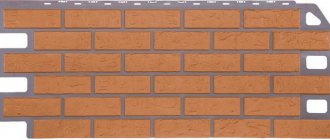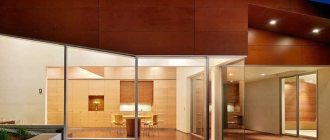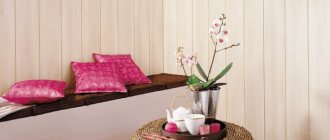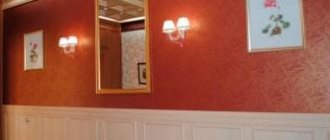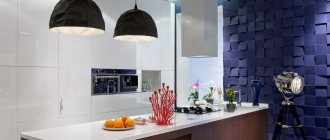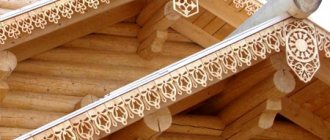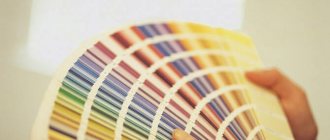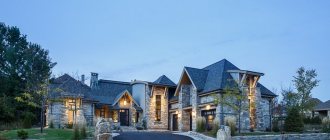Siding, what is it?
Basement siding consists of solid panel boards of small width that are comfortable to hold in your hands. The side edges of the shields, equipped with special fixing locks and an edge for fastening, are cut at the joints of the simulated masonry. The fastening features make the connecting lines almost invisible.
It is more often used to protect and decorate the facade of a building, fences; in recent years it has become fashionable to decorate interior spaces.
Using stone siding in the interior Source askrov.ru
Panels of various shapes, sizes and colors (up to several shades at a time) are offered. Their prices vary depending on the quality and manufacturer. You can choose options at the most affordable or elite prices.
Material characteristics
Siding that imitates various masonry is a beautiful, reliable and inexpensive finishing material. This is the most popular type of siding and goes well with other types of finishes.
Performance
The thickness of the basement siding is noticeably greater than the usual façade siding. Thickening guarantees resistance to severe mechanical loads, the necessary combination of strength and elasticity. Over time, the coating does not crack or become brittle.
Basement siding has increased impact resistance and wear resistance Source ro.decorexpro.com
The material is resistant to various chemical and biological reagents, does not deteriorate and does not fade under the sun. The stability of rich colors is achieved by adding a large amount of coloring pigment, which affects the final cost of the product, so siding in bright colors is more expensive.
Siding can withstand numerous sudden temperature changes and is characterized by excellent frost resistance. If installed correctly, it can last 40-50 years.
Safety
Siding is made from environmentally friendly components. This is one of the best materials in terms of fire safety; at high temperatures it does not burn, but melts, without emitting harmful substances.
Decorative qualities
Aesthetic appearance is the main advantage of the material: the finished building looks more rich and sophisticated. Stone siding hides all imperfections in the walls, including wiring, water pipes and other communications.
Part of the range of basement siding Source roomester.ru
Basement coverings imitate various types of natural stones, reminiscent of large boulders, flat granite slabs, and white rubble stone. Recently, siding that imitates brickwork has been in high demand. A high-quality coating is not easily distinguished from natural stone.
The unique texture of natural stone with various colors allows you to choose an option suitable for decorating any style: classic, modern, antique.
This is a practical material for decorating hallways, kitchens and even living rooms. Suitable for creating unique decor in bars and restaurants, and other commercial premises.
On our website you can find contacts of construction companies that offer insulation and finishing services for houses. You can communicate directly with representatives by visiting the “Low-Rise Country” exhibition of houses.
Stone siding in the interior of a bar Source ausfina.club
Siding with natural material
Panels imitating natural materials have two main options:
- "under the brick";
- "under a stone"
The variety of colors and textures of stone-look panels will satisfy the most demanding buyers who want to make their home unique in their own way. The color line is presented in the following options: “white stone”, “beige stone”, “gray stone” or “cream stone”. These “pure” colors will make your home look fresh and elegant.
The desire to “age” a house will lead its owner to the decision to choose the material “burnt stone” or “desert-colored stone.”
And the cladding made of “Bordeaux-colored stone” will add sophistication and originality to the house.
And this, of course, is not all the varieties of finishing material colors that the market provides.
Siding cladding has advantages:
- speed of work compared to plastering and painting walls;
- the ability to hide irregularities and communications, since the panels are installed on the sheathing;
- insulation, which is placed under the covering, makes it possible to keep the house warm in cold weather.
Installation
What you need to know during installation.
- Basement siding panels are much shorter than usual; Their length is 79.5 cm;
- As a result of expansion and contraction, the panel will change length up to 3-4 mm;
- Installation is carried out using a lock that connects the panels with the required gap;
- Basement siding wild stone in the photo of houses has only its own profile of the starting strip;
- External corner profiles have recently been replaced with overhead ones; They are attached to a special external part (the main cladding is made, then it is covered with a corner profile)
- It is recommended to install it on a metal or wooden sheathing; It will ensure even laying of the panels;
- Before installing the panels, hydro- and then thermal insulation is laid on the sheathing;
- Installation must be done from left to right and start from the lowest point;
- The main thing is to place the first panel evenly and parallel to the surface of the earth and set a mark;
- ;Transfer the mark made on the first wall to all the others;
- The facade panel must be secured with locks without pressing;
- Fasteners (nails, screws) must enter 11mm into the surface of the sheathing;
- When working with it, the panel material must have a positive temperature; This will enable it to be flexible, which is of no small importance during installation;
- After completing the installation work, it is necessary to apply a protective wax-based coating.
You can familiarize yourself in detail with the progress of installation work by viewing what is presented here.
Summary.
By carefully studying the collections in construction supermarkets and on portals on the Internet, you will find what you need to reproduce your idea and make your wildest dreams come true.
Video description
You can see how different houses lined with such siding look thanks to this selection:
Convenient operation
Significant strength characteristics and resistance to external factors do not require additional maintenance efforts throughout the entire period of operation. There is no need for tinting or filling cracks that have nowhere to appear.
Siding stone, unlike a natural material, is lightweight, which greatly facilitates loading, assembly and installation work, and reduces transportation costs. The material is suitable for finishing old buildings that cannot withstand heavy structures.
Cladding an old building will hide external imperfections Source bg.decorexpro.com
It does not require complicated maintenance; dust deposits can be easily washed off with a stream of water from a hose.
Are there any disadvantages?
The material has only one obvious drawback - it does not have the strength of natural stone. The siding is made of high-quality material, but it can be destroyed by a strong impact, and to replace one panel you will have to dismantle a decent area.
Decorative stone panels for facade cladding
Advantages of stone-look facade panels
Decorative
Summarizing all of the above, one thing we can say is that there has never been a building material that could change the appearance of the entire house in a short time. Thanks to this finishing, which has excellent decorative properties, the facade can be transformed before your eyes. Moreover, installation is carried out without the use of expensive equipment. The panels are attached to each other, which speeds up the process of cladding the house; everything happens without installing any special frames.
For a country house, finishing the facade with decorative stone panels will be an excellent solution. Any house in such attire will be transformed and come to life against the backdrop of the composition of the local landscape. A wide palette of colors allows you to choose an individual shade that will perfectly fit into the surrounding countryside landscape.
Insulated
By installing panels under stone, two problems are solved at once. One of them is external beauty, and the other is comfort. After all, the foam layer of material is perfectly used as insulation. Expanded polystyrene has excellent thermal insulation characteristics , which are significantly superior to polystyrene foam.
Thanks to this, two goals are achieved: insulation and renewal. Thus, there is no need for additional expenditure on façade insulation. This technology can significantly reduce heat loss, especially noticeable during the cold season. Plastic facade sheets that look like stone protect the house well from dampness and fungus; this material completely eliminates mold.
Types of siding
Domestic and foreign manufacturers produce various types of sidings. Russian enterprises use foreign equipment, adopting the accumulated experience of Western manufacturers. The following coatings are offered for sale:
- Metal. It is made of galvanized steel sheets coated with polymer. Layers of protective and decorative composition are applied to a stamped relief that replicates various types of masonry. The stone-like surface of metal siding exactly replicates natural stone. Siding of this type is durable, resistant to deformation, and resistant to fire. Disadvantages of the material: high cost, heavy weight and poor sound insulation. It easily transmits any sound, such as raindrops and gusts of strong wind.
- Vinyl. It has similar external characteristics and can be used to perfectly imitate natural granite, marble or sandstone. This type of siding is much lighter than metal, but has lower strength properties.
- Acrylic coating. Its characteristics are similar to vinyl covering. The manufacturing technology is based on the use of modern acrylic polymers, which explains the higher resistance to heat and chemical aggressive environments. The cost of the material is higher than vinyl.
Different colors of basement siding Source stroy-podskazka.ru
This might be interesting!
In the article at the following link, read about metal siding block house.
New
Our compatriots recently learned about the existence of fiber cement siding. The panels, the thickness of which reaches 10 mm, are not only durable, but also heavy (weight of 1 m2 is about 15 kg). In addition, this is the most expensive material of all the presented options; its cost is higher than that of natural wood. Even excellent resistance to atmospheric and mechanical loads and high fire safety do not contribute to its widespread use.
Fiber cement siding in cladding Source bricknews.ru
Features of installation of facade panels
Installation of panels
Steel or aluminum composite facade cassettes imitated with stone have high strength, long service life, and fire safety. The metal surface is produced with imitation stone. The color of the polymer makes it resistant to ultraviolet radiation. Recommended for use when the manufacturability of the cladding comes first - they look ultra modern.
Compressed wood fibers with binders, from which stone-look wood panels are made - HPL panels. They are light, durable, frost-resistant. The material is inferior to other types in terms of fire safety, but is superior in its anti-vandal properties.
Fiber cement is a material based on a mixture of cement and fibers. It does not burn, is resistant to moisture, durable, but is heavy and difficult to process. Installing panels under stone with your own hands is difficult. Japanese fiber cement, which does not contain asbestos, is popular, making it environmentally friendly.
Surfaces that imitate panels:
- Rock is a texture that is formed when large pieces are chipped with a difference of 100 mm.
- Dotted - a flat surface with chips, which is used for cladding buildings in a classical style.
- Heat treatment - gives it an old look with chips and peeling. Polished stone imitates a rough, smooth surface.
- Sawn stone is a surface with longitudinal grooves, suitable for cladding a plinth.
- Polished stone – repeats the mirror surface of artificial polished stone.
- Polished – has a matte smooth surface.
Some stone-look facade panels are produced using injection molding - raw materials are poured into a mold. The form is made as a cast from the surface of the stone and repeats the features of the texture. Stone-look façade panels are divided into:
- Combined – polymer thermal panels.
The first type has advantages over the second - the outer layer is made of polymer (durable material), and the inner layer is made of polystyrene foam. It is considered an excellent insulation material. Sometimes, instead of this insulation, mineral wool is used, which is combined with a plastic coating that imitates brick or stone without the use of glue or locks.
A composite facade panel with a stone look, in which a layer of polyurethane foam is 4-8 cm, and the outer layer is artificial stone (for clinker, ceramics, porcelain stoneware). Service life up to 50 years. A facade made of such panels does not require additional insulation or reinforcement.
Isosiding is a slab made of reinforced polystyrene foam with a 3 mm acrylic coating. Service life up to 10 years. Installed in areas with a temperate climate.
We suggest you familiarize yourself with: Doors to the steam room opening dimensions
Thermal siding is a composite sheet in which marble chips are applied to a polystyrene foam board. They are durable and moisture resistant.
- Made of PVC (its derivatives) with a single-layer structure - plastic sheathing.
Facade vinyl panels imitating stone are made from PVC with different midifiers that increase fire resistance and strength. PVC boards have low thermal insulation qualities. Therefore, their installation requires additional insulation of the facade with some kind of material.
The plastic sheets are lightweight and installation of the sheathing is easy. They are used for finishing any building: a wooden house, reinforced concrete building, etc. The blocks are fixed to the sheathing and glued to the surface. They are not afraid of water, do not rot, and are not affected by mold. Stone-look vinyl wall panels do not change when exposed to temperatures of 50 or -50 degrees, but are damaged by direct impacts, especially from something sharp.
- Facade textured DSP board milled to look like brick and stone.
This is a sheet material with a hard, smooth gray surface, the components of which are wood shavings, Portland cement, and additives. Durable building material has a monolithic structure and a smooth surface. Cement particle boards are easy to cut and drill. They are milled and polished.
It is fireproof and moisture resistant (does not swell more than 2%). Has good noise insulation properties. The material does not rot and is not susceptible to insects or microorganisms. Can be used in any climatic conditions, even extreme ones. It contains no harmful additives.
Before covering the house with brick-like façade panels, the surface is prepared - the walls are cleaned of dust and dirt, and cracks are sealed with putty. After drying, treat with sandpaper. The next step in installation is the following:
- Setting the starting bar;
- External corner fastening;
- Panel installation;
- Installation of the final panel in a row;
- Installation of the following rows;
- Installation of J-profile;
- Installation of curb;
- Installation of additional elements.
At the final stage, the entire surface of the panels must be treated with grout. To do this, pour the dry mixture into warm water in a ratio of 1:5, stir for 5 minutes, and leave to harden for 2 minutes. Afterwards, the resulting solution is passed over the entire facade, applying grout with an oil spatula. After drying, the new façade of the building is washed.
Facade panels for exterior decoration that imitate stone are not only an excellent design solution for the appearance of a building, but also a solution to save money. The cladding gives a feeling of integrity to the building and imparts majesty to it. Artificial stone panels have many varieties with many advantages. Therefore, choosing a cladding option that satisfies all the conditions is not difficult.
- Panels with insulation
You may be interested in reading about plinth panels and sub-brick (stone) panels. ... Georgy Borisovich on Panels for finishing the facades of private houses. Roman Pavlovich Muravyov, façade worker with 5 years of experience to record... - Plastic panels
The under-stone panel is completely identical to the under-brick wood panel. ...Additional elements are designed to complete the finishing of the facade and serve as an ideal complement to plastic panels.
- Finishing the base with natural stone panels
Next comes the finishing process of the base stone. Finishing the foundation with panels should be done carefully and strictly on the frame. ... Georgy Borisovich on Panels for finishing the facades of private houses.
- Panels for finishing facades of private houses
Facade panels are siding that is decorated to look like stones or bricks. ... There are two types of panels for finishing the facade of a house with stone: with insulation and without.
- Which is better: siding or plaster?
Georgy Borisovich on Panels for finishing facades of private houses. ... Konstantin Sergeevich to the entry Peculiarities of facing facades with Dagestan stone.
- Review of façade slabs: hpl panel, rock panel, thin…
Finishing ventilated facades with HPL panels is not afraid of water. ... As expected, the decor of the film can be anything, but standard slabs, of course, are sub-stone, sub-brick, wood-look.
Most sheets have pre-drilled holes. If there are none, you will need to make them yourself before attaching them. It is important to control the curvature during brick cladding, because even one incorrectly installed sheet can ruin the entire picture.
Experienced builders do not recommend relying on measurements when attaching a new sheet. It is better to apply the panel directly to the desired place - this is how you can avoid mistakes. To get a perfect imitation of brickwork, it is necessary to seal the seams with cement mortar.
When installing facade panels under brick, it is important to constantly monitor the curvature
At the next stage, the ducts and slopes are lined to ensure the tightness of the structure. Upon completion of the work, the seams should be treated with polyurethane foam. In order not to spend money on extra panels, it is recommended to first lay out the material on graph paper, taking into account the parameters specified in the product characteristics. When calculating the number of sheets, it is necessary to take into account the following parameters:
- the total size of the wall minus door and window openings;
- length from the corner to all openings;
- distance between windows and door;
- height from base to top edge.
If there are no ready-made holes in the sheet, you will need to make them yourself before installation.
- careful inspection of the surface;
- leveling unevenness if necessary;
- installation of brackets;
- gluing insulation to the wall;
- making holes for dowels using a drill with a Pobedit tip;
- driving in “umbrellas” - at least 5 pieces per sheet;
- installing a vapor barrier film using a construction stapler;
- securing the sheathing;
- installation of facade panels under brick.
It is important to know that if mineral wool rather than polystyrene foam is used as insulation, then in general the progress of work looks the same. The only distinguishing point is the elimination of the stage of gluing the heat-insulating material.
How to make the right choice
Before purchasing, you should familiarize yourself with all the characteristics of the materials. Key factors to consider when choosing the type of finish:
- the condition of the foundation and the quality of the walls that can withstand the increased mass due to the coating;
- the area to be covered, which determines the weight and total cost of the work.
When choosing between the most common metal or vinyl coverings, you need to decide what is more important: strength or lightness.
Stone-like metal siding, heavier and more durable, is suitable for finishing small buildings made of brick, concrete and metal-concrete slabs. Its price is higher than acrylic or vinyl coverings.
Metal siding panel Source fasad-exp.ru
Vinyl siding is less reliable, more fragile at sub-zero temperatures, but lighter. It is advisable to use it for large buildings or frame structures. A definite advantage is the lower price.
Vinyl panel Source m.2gis.ru
Experts recommend using metal siding to cover the basement, and vinyl-based siding to cover the rest of the building’s façade.
Advantages of stone panels in the decoration of private and commercial households
Lightweight, durable, moisture-resistant products are easy to install and do not create additional load on the walls and foundation. They serve for decades, are fireproof, and do not contain toxic compounds. Externally they are no different from natural stone, but are much cheaper. With minimal care, they retain their original characteristics for a long time without the need for repairs or complete replacement.
A large selection of textures and shades is ideal for creating an elegant background for a home and highlighting the beauty of individual architectural elements. Suitable for both decorative cladding of facades of new buildings and reconstruction of old ones. The panels are easy to process, which makes installation possible in areas with intricate configurations, columns, canopies, and arches.
Nuances of installation work
The technology for installing siding under stone is carried out in strict sequence. Important installation rules:
- Mandatory sealing of cracks in the wall discovered during inspection with putty or plaster.
- Depending on the number of layers of insulation, 1 or 2 layers of sheathing are performed. Lathing for insulation - horizontally installed wooden blocks or metal guides. The main layer is vertical sheathing.
- The layers of insulation are laid close to each other, the voids are filled with polyurethane foam.
- The layers of the waterproof membrane are laid overlapping, the joints are taped.
- Vertical strips are installed on top of the waterproofing to secure the siding.
Siding installation Source otdelka-expert.ru
The durability of the structure depends on the quality of the preparatory work. The next stage is installation of siding.
What is important when installing panels
Basement material, unlike façade material, does not require fastening H-straps, which is another important advantage. What is important to know when installing siding:
- work begins from the corner, for which the panel is cut along a vertical line, then installed in place in the profile;
- the second row is installed in such a way that the panels are joined in different places (to do this, the first corner panel is cut in half);
- Do not install siding elements end-to-end or screw the screws in until they stop.
The coating must have some mobility and have a so-called temperature gap. This condition is mandatory when installing vinyl siding.
You can install siding yourself, although it will be easier to invite several experienced craftsmen.
Advantages of panels
Installation of stone panels is faster than laying decorative bricks. Another feature is the possibility of installation regardless of weather conditions. Other features:
- Saving. To evaluate the benefits of using decorative cladding, it is enough to calculate all the costs. In the case of decorative bricks, the total amount will not be 2-3 times higher.
- The difference is in the use of materials - decorative brick can become covered with plaque and stains over time from constant exposure to street moisture, which is not the case with façade panels.
- Easy to install and dismantle. The plates have special locks that can be easily snapped into place. There is no need to carry out preparatory work for wall cladding.
- Light weight. Installation is easy due to its low weight, there is no unnecessary load on the façade of the building.
- Possibility of insulating facades. Before laying the cladding on the wall, you can lay insulation to retain internal heat.
- Appearance. A wide range of. The most popular types of facade panels are: the classic red brick look; soft and romantic decor in peach shades; strict gray-brown tones combined with the greenery of the summer garden. You can combine them.
The panels are easily attached to different surfaces: plaster, concrete, old brickwork.
The panels have special locks, so there is no need to buy glue or solution. Preparing walls for cladding involves creating a frame and laying insulation.
Installation of sheathing
It is not necessary to do this. The panels can be installed directly on the base of the walls. Thanks to the lathing, it is possible to mount additional protection for the facade and secure the panels more securely.
Before starting work, it is necessary to remove all protrusions extending beyond the perimeter of the structure. Next, the installation of the sheathing made of wooden beams or metal profiles begins. When using wood for these purposes, it should be treated with an antiseptic.
To assess how evenly the supports are spaced relative to each other, you can use a thread and beacons. Pay attention to the initial level, the evenness of the rest of the structure depends on it. After installing the horizontal slats, move on to the vertical slats. There is a distance of approximately 50 cm between them.
Installation of panels
Laying begins from the corner of the first row, in a circle. If you have to cut a slab to finish the outside of the house, it is better to place it in the intended place and make a mark. Next, use cement mortar to grout the joints.
Brick finishing always looks expensive and attractive, but, in addition to the fact that the material itself is considered quite expensive, its installation will also cost a decent amount. Additionally, you will have to spend money on transportation and storage if necessary. Another disadvantage of using natural brick is the lengthy installation process, which requires the involvement of qualified masons. Even despite the high cost, cracks may appear on the finished masonry over time, and the brick itself may lose its original color.
Brick-like facade panels have a lot of advantages, one of which is the ability to use sheets on any surface
Imitation brick panels have a lot of advantages, among which the main one is the ability to use sheets on any surface. It is equally appropriate to mount the material on the walls of wooden, stone or brick houses. Moreover, installation of sheets can be carried out at almost any time of the year.
Due to the manufacturing features, the panels not only play the role of finishing, but are also considered an excellent insulation material. Many builders also pay attention to such an important fact as a small amount of waste during installation. As a rule, this figure does not exceed 5%, which significantly reduces purchasing costs.
On trading floors you can find a large number of different options for decorative brick panels: sheets can imitate new brickwork, old or burnt brick. You can also show your imagination and, when making masonry joints, choose surfaces that are different in appearance, which can be smooth or embossed.
Brick-like facade panels have a long service life
- Convenience and ease of installation. The process of laying panels does not require extensive experience or any special skills that are necessarily required when carrying out brickwork. If you have a little experience, facing a house with brick-like panels can be easily done without the involvement of professionals.
- High speed of work. The finished panel is characterized by a fairly large surface, which makes it possible to cladding the facade in the shortest possible time.
- Good operating parameters. Manufacturing features allow the material to be used at high humidity and under conditions of large temperature changes. It is possible to finish the façade panels with constant exposure to sunlight.
- Long lifespan. In terms of durability, the material is not inferior to natural brickwork.
- No chance of salt stains. Natural building material is distinguished by its ability to absorb surrounding moisture, which contains a certain amount of salts. After time, salt deposits appear on the surface of the bricks, which spoils the appearance, but if facade panels are used, such a problem will not arise.
- Light weight material. Facing brick is characterized by a significant mass, which affects the foundation, so it is not recommended for use when renovating an old house. Facade panels for facing bricks have less weight, which reduces the load on the supporting structure.
- Large selection of products. You can create a beautiful façade by combining panels of different colors and textures.
- High strength indicators. The panels, unlike siding, are designed to withstand heavy loads and also resist mechanical damage.
Facade panels for facing bricks are lightweight, which reduces the load on the supporting structure
As for the sizes of brick façade panels, the parameters are quite varied. Products can be either small-sized individual elements or large-sized sheets with a height of three meters. Some manufacturers practice selling narrow stacked panels of increased length, sheet profiles and sandwich panels folded in several layers.
We invite you to familiarize yourself with: Brick for lining a sauna stove
A large selection of different panels allows you to choose the best option for cladding the facade in any of the modern or classic styles. The basis of brick panels for exterior decoration are components of natural origin, among which the following materials stand out:
- wood fiber;
- various minerals;
- glass;
- fiber cement or cement-fiber material;
- aluminum and steel;
- copper;
- zinc;
- PVC and other polymers.
Some manufacturers use fine-grained marble or stone chips to decorate the surface of panels
Fiber cement brick panels, due to the characteristics of the materials used and production technologies, are distinguished not only by good flexibility, but also by bending and compressive strength. The manufacturing process consists of three stages. First, all the necessary components are mixed. The finished solution is poured into molds, where it remains until completely dry. The last stage is the application of the finishing coating and protective layer.
A large number of positive characteristics are provided thanks to cellulose, which is necessarily present in the mixture. It is this component that gives the material strength and moisture resistance. The main characteristics due to which fiber cement facade panels for exterior decoration have become widespread:
- low flammability and lack of possibility of spontaneous combustion;
- high bending strength - about 24 MPa;
- linear deformation not exceeding 2%;
- ability to withstand 100-150 cycles of freezing and thawing;
- the level of water absorption does not exceed 20%;
- residual strength – at least 90%;
- density – 1550 kg/m³.
The main advantage of polymer-sand brick wall panels is their low cost compared to other types of facing slabs. The second important advantage is increased strength, which makes it possible to use building materials for finishing not only the façade, but also the basement. An indisputable advantage is that the sheets belong to the self-extinguishing class.
Fiber cement brick panels are characterized by good flexibility, bending and compressive strength
All popular manufacturers of polymer sand slabs offer customers a large selection of color variations. Wall decoration can be done using any shade of the red spectrum, and it is also easy to choose the appropriate texture. Many companies use fine-grained marble or stone chips to decorate the surface of panels, which, in combination with the falling rays of the sun, creates a unique and spectacular appearance.
Metal facade panels imitating brickwork look especially attractive. In fact, this type of panel is ordinary siding, the surface of which resembles brickwork. Often the imitation looks so believable that it can only be distinguished from the original upon closer examination. The main advantages of using metal panels for exterior finishing of a brick house:
- non-flammability;
- resistance to temperature changes;
- maintaining shape in dry or too humid weather conditions.
Metal facade panels look presentable and beautiful
Brick imitation panels
Famous manufacturers
In our country and abroad, many manufacturers have mastered the production of various types of stone siding. The most reliable companies from Russia:
- Alta Profile is the largest domestic manufacturer, producing a huge number of different types of siding at a variety of prices, including rocky stone, granite, canyon, bassoon, rubble stone.
Panel from Alta Profile Source nsk-stroy.com
- Royal Stone, distinguished by a wide range of shades, corresponds to European quality.
Panel from Royal Stone Source stroika-market.ru
- T-siding offers the most popular series, which include alpine rock, Leon granite, wild stone and others at affordable prices.
Panel from T-siding Source perm.yamart.ru
The Russian-German company Wandstein offers a huge selection of stone siding of excellent quality. High-quality Nailite products (USA) accurately imitate natural stone and are offered at realistic prices.
This might be interesting!
In the article at the following link, read about insulation for siding.
